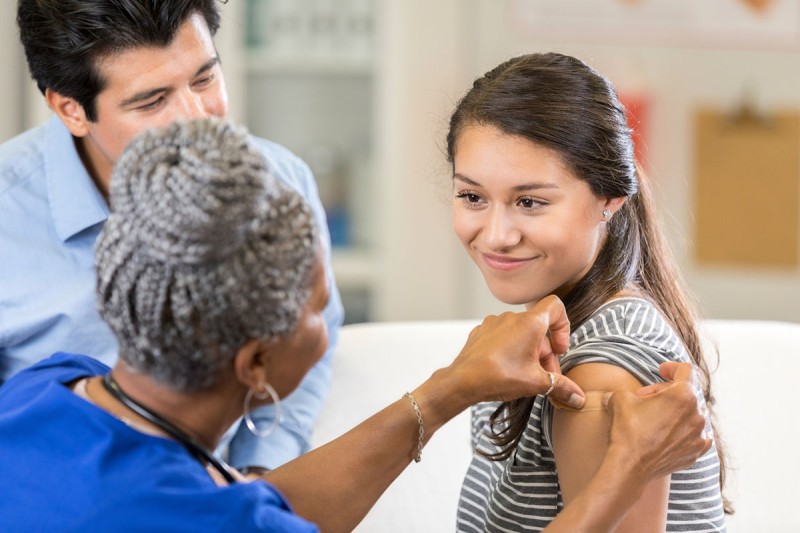
Experts strongly recommend vaccination against HPV, which causes a disproportionate share of cancers among Hispanics.
The vaccine against the human papillomavirus (HPV) has proven to be a remarkably potent weapon for preventing several kinds of cancer. But experts believe that far too few people are getting the vaccine. That leaves many people exposed to cancers that could be prevented. This is particularly true in Hispanic communities across the United States, which suffer a disproportionate share of the cancer caused by HPV.
Here are some common questions and answers relating to HPV-related cancers.
How common is HPV?
HPV is the most common sexually transmitted disease in the United States. Research shows that the vast majority of people — men and women of all races — between 18 and 55 years old will have the infection at some point in their life. The good news is that most people have a strong immune system, which clears out the virus, often after a few years. But about 10% of people will keep the virus in their body, and it can cause cancer years or decades after infection.
How many cases of cancer are linked to HPV?
Every year, more than 40,000 people in the United States are diagnosed with a cancer caused by HPV. Cervical cancer is the most common. But there are other cancers linked to HPV, including vaginal cancer, anal cancer, penile cancer, and some cancers in the back of the throat. Diagnoses for some of these cancers are on the rise, although they remain relatively rare.
Even when HPV doesn’t cause cancer, the infection can cause genital warts. Many people have to suffer the anxiety and expense of testing procedures if HPV or precancerous cells are found during screening.
How does HPV affect the Hispanic community specifically?
The vast majority of cervical cancer in the United States is diagnosed in Hispanic women. Research suggests as many as 75% of cases. In the United States, Pap and HPV tests are used to examine the cervix for precancerous cells. These kinds of screening represent a huge advance in detecting and preventing cervical cancer, which used to be one of the most common causes of death for women. However, in many places around the world, including Latin America, testing is much less common, and cervical cancer remains a major problem. When people emigrate from those areas, those health issues can persist.
There is also growing evidence that Hispanic women may develop cervical cancer linked to HPV at an earlier age than the overall population. This may be because they have other risk factors, such as obesity or smoking. Together, these make it more likely that a woman with HPV will develop cervical cancer.
How do rates of HPV vaccination compare between Hispanic communities and the overall population?
There are wide disparities in vaccination across the United States. One big difference is living in a metropolitan area. In cities like New York City and Los Angeles, vaccination rates among all young people are often higher than 60%. It’s encouraging that among young Hispanics in these cities, the rates of vaccination are often even higher, more than 65%.
But outside metropolitan areas, vaccination rates fall off steeply for both the Hispanic and overall population. Across the United States, just under 50% of all people who should be vaccinated against HPV get the full regimen. Either two or three shots are needed, depending on age. That rate is far below the 80% that public health experts believe we should achieve by 2020.
Why are HPV vaccination rates overall much lower than experts believe is appropriate?
There are many reasons. Some parents simply aren’t aware that HPV, particularly the high-risk types called HPV 16 and HPV 18, can cause several types of cancer. That’s true for parents of all ethnicities. In research with Hispanic parents, some who were unaware of the connection between HPV and cancer said they would definitely vaccinate their children after learning about it.
Some parents disapprove of vaccines. But that sentiment is less common among Hispanics overall. Research shows that Hispanic parents are supportive of vaccination and make sure their kids get their shots.
That underscores another problem that is sometimes referred to as “the missed opportunity.” Many children are vaccinated with the Tdap (tetanus, diphtheria, and pertussis) and meningococcal vaccines around 11 or 12 years of age. These shots protect them against a variety of diseases. But many of these kids don’t receive the HPV vaccine, though it is recommended to be administered at the same age.
Many experts in public health believe that doctors and nurses should be just as definitive with parents about the need for the HPV vaccine as they are about Tdap and meningococcal. The HPV vaccine is safe, and it’s covered by insurance or government programs everywhere in the country. It can dramatically reduce the risk of some very serious cancers, as well as the other problems caused by HPV. This opportunity to begin the two-shot protocol for the HPV vaccine should not be missed.
How is MSK helping to increase awareness of HPV among Hispanics?
MSK conducts outreach programs to reach healthcare workers as well as parents, to make them aware of the prevalence of HPV in the community, to educate them about the link between HPV and cancer, and to encourage vaccination. These efforts are often in Spanish, using native speakers, and people have been very receptive.




